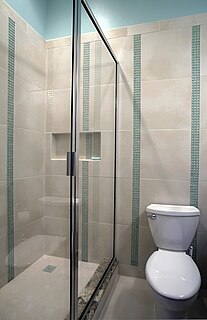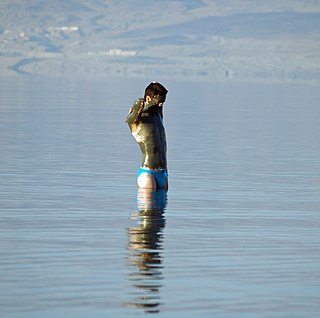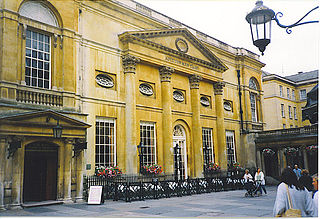
A bathroom is a room in the home or hotel for personal hygiene activities, generally containing a toilet, a sink (basin) and either a bathtub, a shower, or both. In some countries, the toilet is usually included in the bathroom, whereas other cultures consider this insanitary or impractical, and give that fixture a room of its own. The toilet may even be outside of the home in the case of pit latrines. It may also be a question of available space in the house whether the toilet is included in the bathroom or not.

The Roman Baths complex is a site of historical interest in the English city of Bath. It is a well-preserved Roman site once used for public bathing.

The Baths of Diocletian were public baths in ancient Rome, in what is now Italy. Named after emperor Diocletian and built from 298 AD to 306 AD, they were the largest of the imperial baths. The project was originally commissioned by Maximian upon his return to Rome in the autumn of 298 and was continued after his and Diocletian's abdication under Constantius, father of Constantine.
A spa is a location where mineral-rich spring water is used to give medicinal baths. Spa towns or spa resorts typically offer various health treatments, which are also known as balneotherapy. The belief in the curative powers of mineral waters goes back to prehistoric times. Such practices have been popular worldwide, but are especially widespread in Europe and Japan. Day spas are also quite popular, and offer various personal care treatments.

A mud bath is a bath of mud, commonly from areas where hot spring water can combine with volcanic ash. Mud baths have existed for thousands of years, and can be found now in high-end spas in many countries of the world.

The Baths of Trajan were a massive thermae, a bathing and leisure complex, built in ancient Rome starting from 104 AD and dedicated during the Kalends of July in 109. Commissioned by Emperor Trajan, the complex of baths occupied space on the southern side of the Oppian Hill on the outskirts of what was then the main developed area of the city, although still inside the boundary of the Servian Wall. The architect of the complex is said to be Apollodorus of Damascus. The baths were being utilized mainly as a recreational and social center by Roman citizens, both men and women, as late as the early 5th century. The complex seems to have been deserted soon afterwards as a cemetery dated to the 5th century has been found in front of the northeastern exedra. The baths were thus no longer in use at the time of the siege of Rome by the Ostrogoths in 537; with the destruction of the Roman aqueducts, all thermae were abandoned, as was the whole of the now-waterless Mons Oppius. Early Christian writers misnamed the remains the 'Baths of Domitian'.

Bathing played a major part in ancient Roman culture and society. It was one of the most common daily activities in Roman culture, and was practiced across a wide variety of social classes.

A steambath is a steam-filled room for the purpose of relaxation and cleansing. It has a long history, going back to Greek and Roman times.

The Grand Pump Room is a historic building in the Abbey Church Yard, Bath, Somerset, England. It is adjacent to the Roman Baths and serves refreshments including water from the baths' hot springs. It has been designated as a Grade I listed building since 1950. Along with the Lower Assembly Rooms, it formed a complex where social activity was centred, and where visitors to the city gathered.

The Cross Bath in Bath Street, Bath, Somerset, England is a historic pool for bathing. It was rebuilt, in the style of Robert Adam by Thomas Baldwin around 1789. It is recorded in the National Heritage List for England as a designated Grade I listed building, and was restored during the 1990s by Donald Insall Associates.

Aquae Iasae was the Roman settlement and Roman bath in the area of present city Varaždinske Toplice, Croatia. Today it is the name of the archaeological site.

Thermae Romae, styled as Thermæ Romæ, is a Japanese manga series by Mari Yamazaki. It won the third Manga Taishō and the Short Story Award at the 14th Tezuka Osamu Cultural Prize. The manga has been licensed in North America by Yen Press. Fuji TV produced a live-action film adaptation and released on April 28, 2012. A second film was released in 2014. An anime television adaptation by DLE Inc. aired in Japan on Fuji TV's Noitamina block in January 2012. The show has been licensed by Discotek Media in North America, and by Siren Visual in Australia.

The Roman Thermae are a complex of Ancient Roman baths (thermae) in the Black Sea port city of Varna in northeastern Bulgaria. The Roman Thermae are situated in the southeastern part of the modern city, which under the Roman Empire was known as Odessus. The baths were constructed in the late 2nd century AD and rank as the fourth-largest preserved Roman thermae in Europe and the largest in the Balkans.

Roman Berytus are located in the middle of downtown Beirut, Lebanon between Banks Street and Capuchin Street. The remains of a Roman bath of Berytus now surrounded by government buildings were found and conserved for posterity.
This page is based on this
Wikipedia article Text is available under the
CC BY-SA 4.0 license; additional terms may apply.
Images, videos and audio are available under their respective licenses.














